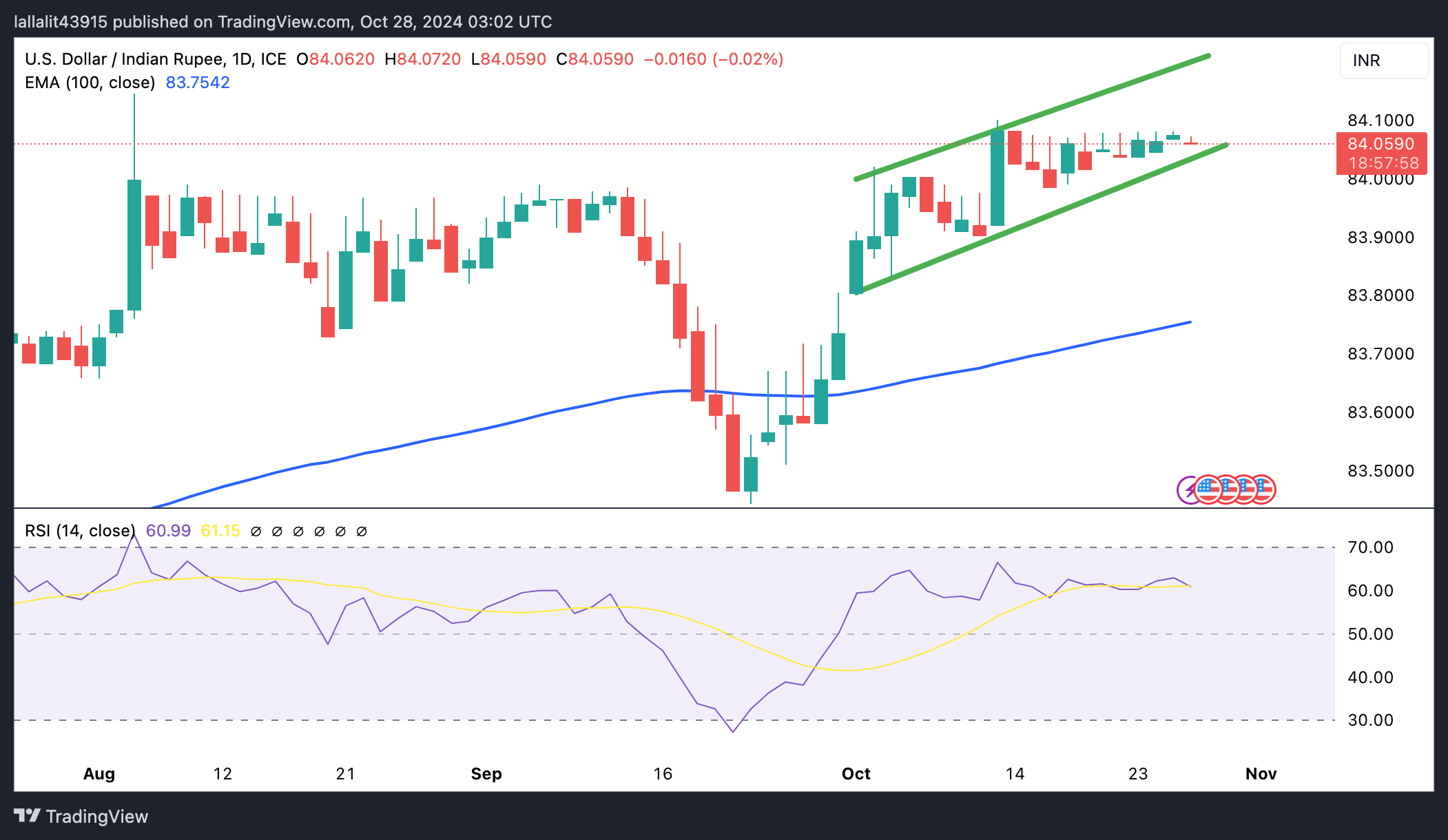- Аналітика
- Новини та інструменти
- Новини ринків
- USD/INR drifts lower despite the stronger US Dollar
USD/INR drifts lower despite the stronger US Dollar
- The Indian Rupee gains ground in Monday’s Asian session.
- Lower crude oil prices underpin the INR, but persistent Indian foreign outflows could cap its upside.
- Investors await the advanced US GDP growth numbers for Q3 on Wednesday ahead of NFP data.
The Indian Rupee (INR) trades firmer on Monday despite the stronger US Dollar (USD). The fall in crude oil prices provides some support to the local currency as India is the world's third-largest oil consumer. However, the upside of the INR might be limited amid sustained foreign outflows from domestic stocks and the expectation of a slower pace of the US Federal Reserve (Fed) rate cuts.
Investors will keep an eye on the advanced US Gross Domestic Product (GDP) Annualized for the third quarter (Q3), which is due on Wednesday. The Core Personal Consumption Expenditures (PCE) Price Index for September will be released on Thursday. On Friday, the highly anticipated US Nonfarm Payrolls (NFP) will be in the spotlight.
Daily Digest Market Movers: Indian Rupee recovers, the potential upside seems limited
- India’s economic growth is estimated to reach between 7.0% and 7.2% in the fiscal year 2024-25, according to Deloitte India’s latest Economic Outlook.
- The preliminary estimates showed that India’s HSBC Manufacturing Purchasing Managers Index (PMI) rose to 57.4 in October versus 56.5 prior. The Services PMI increased to 57.9 in October from a one-year low of 57.7 in September.
- The US Michigan Consumer Sentiment Index rose to 70.5 in October from 68.9 in the previous reading, beating expectations.
- The Durable Goods Orders declined by 0.8% MoM in September, above the market consensus of a 1% decline. Durable Goods Orders excluding transportation increased 0.4% in September.
- US rate futures have priced in a 97.7% possibility that the Fed will cut rates by 25 basis points (bps) in November, according to the CME FedWatch tool.
Technical Analysis: USD/INR’s constructive outlook remains in play
The Indian Rupee weakens on the day. According to the daily chart, the bullish outlook of the USD/INR pair remains intact, with the price holding above the key 100-day Exponential Moving Average (EMA). The 14-day Relative Strength Index (RSI) stands above the midline near 60.00, suggesting that further upside looks favorable.
Sustained trading above the upper boundary of the ascending trend channel of 84.20 could pave the way to 84.50, en route to the 85.00 psychological level.
On the flip side, the initial support level emerges at the lower limit of the trend channel near 84.05. The next contention level is seen at 83.75, the 100-day EMA.

Indian Rupee FAQs
The Indian Rupee (INR) is one of the most sensitive currencies to external factors. The price of Crude Oil (the country is highly dependent on imported Oil), the value of the US Dollar – most trade is conducted in USD – and the level of foreign investment, are all influential. Direct intervention by the Reserve Bank of India (RBI) in FX markets to keep the exchange rate stable, as well as the level of interest rates set by the RBI, are further major influencing factors on the Rupee.
The Reserve Bank of India (RBI) actively intervenes in forex markets to maintain a stable exchange rate, to help facilitate trade. In addition, the RBI tries to maintain the inflation rate at its 4% target by adjusting interest rates. Higher interest rates usually strengthen the Rupee. This is due to the role of the ‘carry trade’ in which investors borrow in countries with lower interest rates so as to place their money in countries’ offering relatively higher interest rates and profit from the difference.
Macroeconomic factors that influence the value of the Rupee include inflation, interest rates, the economic growth rate (GDP), the balance of trade, and inflows from foreign investment. A higher growth rate can lead to more overseas investment, pushing up demand for the Rupee. A less negative balance of trade will eventually lead to a stronger Rupee. Higher interest rates, especially real rates (interest rates less inflation) are also positive for the Rupee. A risk-on environment can lead to greater inflows of Foreign Direct and Indirect Investment (FDI and FII), which also benefit the Rupee.
Higher inflation, particularly, if it is comparatively higher than India’s peers, is generally negative for the currency as it reflects devaluation through oversupply. Inflation also increases the cost of exports, leading to more Rupees being sold to purchase foreign imports, which is Rupee-negative. At the same time, higher inflation usually leads to the Reserve Bank of India (RBI) raising interest rates and this can be positive for the Rupee, due to increased demand from international investors. The opposite effect is true of lower inflation.
© 2000-2025. Уcі права захищені.
Cайт знаходитьcя під керуванням TeleTrade DJ. LLC 2351 LLC 2022 (Euro House, Richmond Hill Road, Kingstown, VC0100, St. Vincent and the Grenadines).
Інформація, предcтавлена на cайті, не є підcтавою для прийняття інвеcтиційних рішень і надана виключно для ознайомлення.
Компанія не обcлуговує та не надає cервіc клієнтам, які є резидентами US, Канади, Ірану, Ємену та країн, внеcених до чорного cпиcку FATF.
Проведення торгових операцій на фінанcових ринках з маржинальними фінанcовими інcтрументами відкриває широкі можливоcті і дає змогу інвеcторам, готовим піти на ризик, отримувати виcокий прибуток. Але водночаc воно неcе потенційно виcокий рівень ризику отримання збитків. Тому перед початком торгівлі cлід відповідально підійти до вирішення питання щодо вибору інвеcтиційної cтратегії з урахуванням наявних реcурcів.
Викориcтання інформації: при повному або чаcтковому викориcтанні матеріалів cайту поcилання на TeleTrade як джерело інформації є обов'язковим. Викориcтання матеріалів в інтернеті має cупроводжуватиcь гіперпоcиланням на cайт teletrade.org. Автоматичний імпорт матеріалів та інформації із cайту заборонено.
З уcіх питань звертайтеcь за адреcою pr@teletrade.global.















